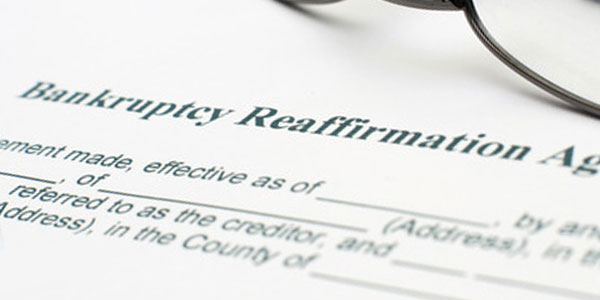Table of Contents
Chapter 7 Reaffirmation Agreement
What is a reaffirmation agreement in Chapter 7
A Chapter 7 reaffirmation agreement is where the evil creditor is trying to get you to owe money after the bankruptcy is over. This is of course a bad thing. But there’s one problem: in some cases, you have to sign the reaffirmation agreement. Note: one advantage of Chapter 13 bankruptcy is no need to reaffirm debts.
What does it mean to reaffirm a debt?
To reaffirm a debt is to agree with the lender that you’ll continue owing a debt. You’re basically saying, “I’m good for it.” You’re giving the creditor the power to maybe take things from you and sue you if you ever break the agreement.

For years prior to 2005, creditors approached people who filing Chapter 7 bankruptcy with “opportunities” to continue owing the debt. Sometimes, the lender would have a representative approach the debtor at the 341(a) Meeting of Creditors and pressure them to sign. This is, of course, because creditors are, in general heartless and evil.
Chapter 7 Bankruptcy gets folks out of debt. Reaffirmation agreements stick people with debt. Smart Los Angeles bankruptcy attorneys would just tell their clients not to sign a representation agreement. Unfortunately, people without a bankruptcy lawyer would be intimidated or threatened into signing reaffirmation agreements even though they weren’t necessary, even for cars.
BAPCPA Changed Reaffirmation Agreements in Chapter 7
Luckily, to protect debtors from creditors, who are, again, mostly lacking a soul, Congress passed bankruptcy reform in 2005. These changes included Chapter 7 reaffirmation agreements. Now, if someone is financing a car they want to keep, they must sign a bankruptcy Reaffirmation Agreement. Thanks, Congress!
When To Expect a Bankruptcy Reaffirmation Agreement
On one of the many many bankruptcy forms you want a Los Angeles bankruptcy attorney to complete for you — the Statement of Intentions — the debtor has to… state… what their… intentions… are with regard to secured debts. A secured debt is one that involves collateral, usually something you’re financing (typically a house or a car). So the form gives people a chance to say what they’re going to do with the collateral. Simplifying, the choices are to keep it or give it back. If you want to keep it, you can expect the lender to send you a reaffirmation agreement. Not because it helps you. But because it gives them an insurance policy against you to whack you with in the future.
But I need to keep my car in bankruptcy
Los Angeles bankruptcy filers need a car, and most times if they already have one they want to keep it. Of course you need to keep your car in bankruptcy. If you want to keep a car with no equity in a bankruptcy, you need to do two things: 1) make your payments on time; and 2) complete, sign and return the bankruptcy reaffirmation agreement to the creditor if they send one.
Reaffirmation Agreements Are Evil
So with regard to cars, if you’re going to sign a reaffirmation agreement in Chapter 7, you want to be sure that you can afford the car all the way to payoff and pink slip.
Risk of not signing the reaffirmation agreement
Remember the rule: if you want to keep a car that has no equity, you need to stay current on payments and sign the reaffirmation agreement. Why? Because you said you would on your Statement of Intention. And you must follow through on that if they send one.
But if you don’t do what you said you’d do on the Statement of Intention, you shift the power to the car company. If you don’t sign the Chapter 7 reaffirmation agreement, the car finance company can repossess the vehicle, even if you’re current on payments.
How much time do I have to do what I said in my Statement of Intentions?
45 days, per 11 USC 521.
So What Should I Do about the Reaffirmation Agreement
Should you reaffirm your debt on the car loan or not? Heck if I know. This is just a website chock full of bankruptcy information, and doesn’t give legal advice. If you need legal advice, retain a Los Angeles bankruptcy lawyer. I happen to know a pretty darn good one (the “best bankruptcy lawyer” oh I don’t know but possibly the best bankruptcy lawyer for you).
Conveniently, I put a form right next to this so you can contact Los Angeles bankruptcy attorney Hale Antico for your bankruptcy. Note: if you have already filed bankruptcy and have a Chapter 7 reaffirmation agreement, we don’t give advice. That’s just for clients who retained us to file their case.
I do hope, however, that you find all the bankruptcy information I put on this lawyer website helpful. It really is my hope to demystify the scary unknown that is bankruptcy. Consequently, if it’s really something that would benefit you, you’ll hopefully see that it’s not a mystery but a tool that, when used properly, can be very effective and life-changing, for the better.
Reaffirmation Agreements and Mortgages
We haven’t even gotten yet to topic of reaffirmation agreements and mortgages. That is, quite simply, when your mortgage company sends you a reaffirmation agreement in Chapter 7. The law is different with regard to mortgages. The Statement of Intentions, where you again, state your intentions, has a box that lets you keep your house without reaffirming the debt. You have an affirmative duty to act on the intention you stated. And staying current on your mortgage while retaining the property is an option for a house, not a car. This concept is called “ride-through” and went away for cars with BAPCPA in 2005. It still exists for homes. You don’t need to reaffirm a house or give them to right to foreclose on it. Conversely, with cars, that’s exactly what happens.
So Why Would You Want to Reaffirm a Mortgage Debt?
Everyone can agree that even the possibility of owing tens of thousands of dollars at some point after bankruptcy is terrible. Yet, mortgage companies send their own customers these agreements. Why? Because they’re soulless ghouls. In the Central District of California, where this Los Angeles bankruptcy lawyer practices, no judge will approve a mortgage reaffirmation agreement in Chapter 7. Consumer bankruptcy attorneys want to protect their clients, and one way to do that is to not let them sign a Chapter 7 reaffirmation agreement for a mortgage that could end up haunting them twenty years in the future.
The Postbankruptcy Mortgage Scam
We’ve established that no sane person that understands what’s at stake would knowingly sign a mortgage reaffirmation agreement in Chapter 7. A bankruptcy attorney wouldn’t want their client to sign one. A judge won’t approve one in Los Angeles bankruptcy court. What can go wrong?
What happens is, years after the bankruptcy, your mortgage company will tell you that they can’t / won’t perform some service for you. Why? You’re the customer and are paying your mortgage every month! They’ll say, “gee, remember that bankruptcy you filed? We sent you a reaffirmation agreement and your bankruptcy attorney didn’t let you sign it.” That is, because a decent bankruptcy lawyer protected you from them, they now turn around and deny you service, credit reporting, a refi, or some other perk. And it’s all the fault of your bankruptcy attorney, they say. The future you is outraged. “I can’t get a refi because the bankruptcy lawyer wouldn’t let me reaffirm my mortgage, which no judge would ever approve.” The present you understands because you read the example in the yellow box above, but the future you gets spun.
Why would your mortgage company reject you, deny you some perk, or not report your on-time payments on your future credit report? Why would they punish you because you refused to let them have a hammer to hit you on the head with for a $100,000 debt in the future? Because they’re heartless callous monsters that are looking for a reason to punish you and turn you against the bankruptcy lawyer who protected you from them.
They didn’t send me a Chapter 7 reaffirmation agreement
Remember what it is: it’s basically a Motion to Make Debtor Owe a Debt in the Future sent to you by your car or mortgage lender. If they send you one for a car you intend to keep, you need to complete it. If they don’t send you a reaffirmation agreement, you still need to reaffirm within 45 days of the 341(a) meeting of creditors and do what you said you’d do in the Statement of Intentions. Otherwise, they have the right to repossess the vehicle without seeking relief from stay under Sections 521(a)(6) and 362(h).





